Conservation Science
Protecting Pennsylvania’s Plants and Animals
Hemlock Woolly Adelgid
Hemlock woolly adelgid (Adelges tsugae) is a small insect that feeds on species of hemlock trees, including Pennsylvania’s state tree, the eastern hemlock (Tsuga canadensis). Not originally found in eastern North America, this exotic invasive species has caused extensive mortality in hemlock trees throughout the region. Forests and streams are greatly affected when eastern hemlock, the most common evergreen tree in Pennsylvania, declines and disappears. The Western Pennsylvania Conservancy is working to control the spread of hemlock woolly adelgid in select stands of hemlock trees on its preserves.

Photo by Ohio State University
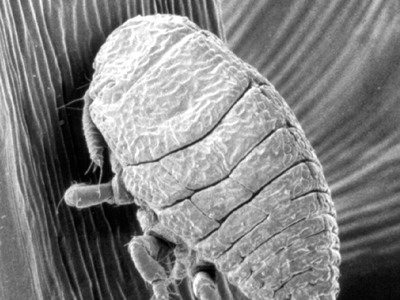
Photo by Richard Hirth, USFS
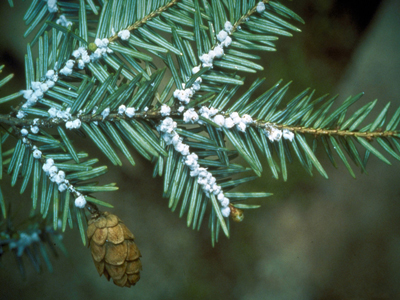
Photo by the Connecticut Agricultural Experiment Archive
Origin
Hemlock woolly adelgid (HWA) was transported as a hitchhiker on nursery plants brought from Japan to the Pacific Northwest in 1924. Following that introduction to North America, it moved to Virginia in the 1950s also on nursery stock. Since then, HWA has spread across much of the range of the eastern hemlock. HWA disperses by wind, as a hitchhiker on birds and vehicles, and on nursery plants. It entered Pennsylvania along the Delaware River in 1967, and expanded west to reach the state of Ohio before 2012.
Effects on Hemlock Trees
HWA causes mortality in species of hemlock trees native to eastern North America including the eastern hemlock and the more southern Carolina hemlock (T. caroliniana). The insect uses its sharp-tipped tube-like mouth to feed on the sap of the hemlock tree, resulting in premature needle drop, branch dieback and the eventual death of the tree. Once the HWA population builds up in an area, the millions of insects found feeding on any single hemlock are enough to kill it over a period of several to dozens of years.
The dramatic decline and disappearance of hemlock trees greatly affects our region’s forest habitats and streams. The results include a reduction in evergreen cover for wildlife and the warming of unshaded streams. The lack of hemlock trees can also cause the decline of species low in food chains, such as moth caterpillars and other native insects that naturally depend upon hemlocks. That loss, in turn, affects species higher on the food chain, such as spiders, insectivorous birds and small mammals. As decomposers, even some fungi feed only on the wood of hemlock trees.
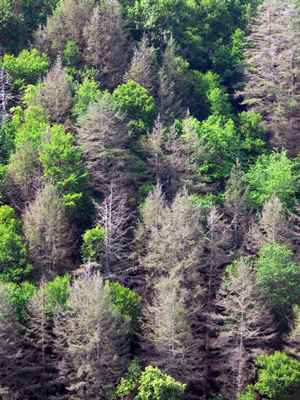
Photo by Jeff Wilhelm, Charlotte Observer.
Controlling Hemlock Woolly Adelgid
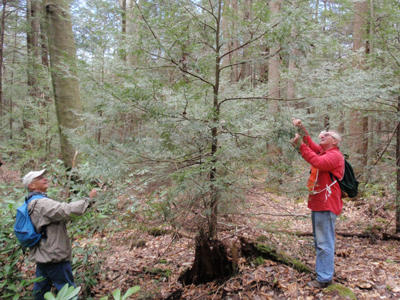 There are many Western Pennsylvania Conservancy preserves where eastern hemlock is a key ecological feature of the forest. HWA was first detected on Conservancy lands along Sideling Hill Creek in Bedford County in 2008. HWA has now been detected at preserves including Bear Run, Marshall, Beaver Creek and Bennett Branch Forest. To date, HWA has not been found at Conservancy preserves in the northwestern corner of the state.
There are many Western Pennsylvania Conservancy preserves where eastern hemlock is a key ecological feature of the forest. HWA was first detected on Conservancy lands along Sideling Hill Creek in Bedford County in 2008. HWA has now been detected at preserves including Bear Run, Marshall, Beaver Creek and Bennett Branch Forest. To date, HWA has not been found at Conservancy preserves in the northwestern corner of the state.
Although there are no means to eliminate HWA at this time, there are several options for its treatment and control. Control methods include chemicals like insecticides or biological methods, such as predators or pathogen treatments.
In order to save some hemlock trees on certain Conservancy lands, limited applications of insecticide are being used on select trees. In an effort to use a non-chemical option, the Conservancy also is using a biological approach that may potentially have wider and long-lasting benefits.
Introducing A Natural Predator: The Ln Beetle
It’s possible to introduce predatory species into an environment as a potential solution to an invasive species. However, such an introduction should only be attempted after careful evaluation and testing. We must be certain that we're not dealing with another invasive species problem in disguise.
In the case of HWA, there is a non-native predatory insect that shows promise for long-term control efforts. The small, 2-3 mm long beetle, called Laricobius nigrinus (Ln), is native to the northern Rocky Mountains and Pacific Northwest, where it feeds on an insect identical to the invasive HWA that is infesting eastern hemlocks. Ln was one of a few insects selected for release at HWA infestation sites in some eastern states beginning in the early 2000s. Unfortunately, Ln has never been given a common name for us to use.
The Conservancy is working closely with the PA Bureau of Forestry to fight the spread of HWA using the Ln beetle. A challenge for such an effort is to establish the predatory beetle population in an area before HWA can kill the hemlock trees. Although Ln already lives in far eastern Pennsylvania and some states to the south, it is unlikely to make its way on its own to western Pennsylvania in time to save the trees.
Acquiring an adequate supply of Ln beetles to release into the wild isn’t an easy task. It takes many individual beetles and several attempted releases to be successful at a particular location. Common options for acquiring the Ln beetle include:
- Rearing the predatory insects in a lab;
- Collecting them in the field and transporting them to the infested area; or
- Purchasing them from a supplier.
Instead, the Conservancy and the PA Bureau of Forestry decided to create a nursery habitat that is suitable for both HWA and the predatory beetle. This allows the Ln beetles to naturally feed on HWA and reproduce in their intended environment. This habitat is referred to as an insectary.
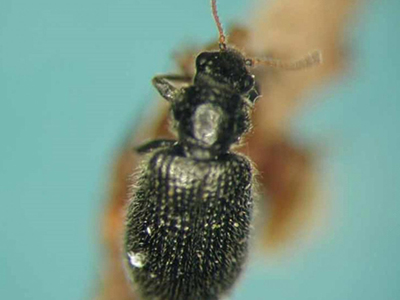
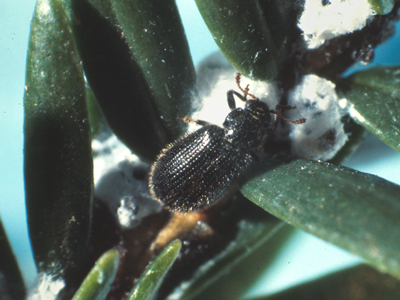
The Ln beetle. Photos by Michael Montgomery, USFS.
Insectary: A Nursery for a Predator
The Conservancy has established two Ln insectaries at Bear Run Nature Reserve using the following method:
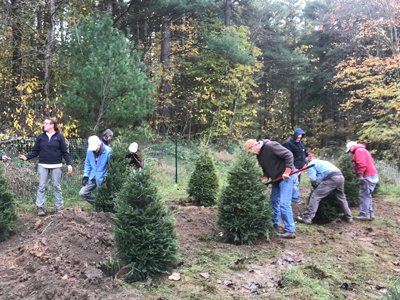
- Plant 12 young hemlock trees in a linear hedge-like configuration and care for them with water and fertilizer.
- Fence the area so deer will not damage the young trees.
- Trim the tree tops and longest branches to encourage a bushy growth form with lots of twigs that are within reach.
- Cut back surrounding vegetation to reduce competition for sunlight and water.
- Introduce HWA into the insectaries by collecting HWA-infected hemlock twigs and placing these along the branches of the young insectary hemlocks. HWA shouldn’t be moved onto a property where it is not already present.
- Wait at least one year to allow the HWA to spread and form a thriving colony within the hemlock hedge.
- Release Ln beetles into the hemlock hedge when the HWA is abundant enough to supply the food necessary to feed a Ln colony.
- Collect Ln beetles once a healthy colony has formed in the insectary and release these at locations where eastern hemlock trees are already infected.
- Check the HWA-infected hemlock trees in the landscape surrounding the insectary to determine if Ln beetles from the insectary have dispersed on their own to prey on HWA elsewhere.
At Bear Run Nature Reserve, the first insectary was planted in 2014, and the second in 2017. After caring for the insectaries as described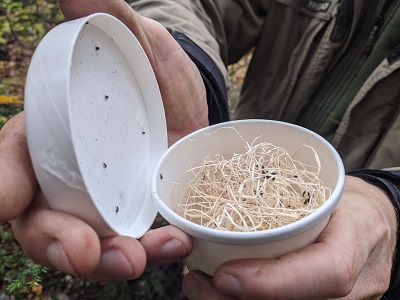 above, HWA was introduced onto the trees in 2020 and again in the spring of 2021. Then, in October 2021, Conservancy and PA Bureau of Forestry staff released Ln beetles that had been collected in Washington and shipped overnight across the country. Almost 500 beetles were placed on the trees in one insectary, 290 in the other, and another 250 released within one of the natural hemlock stands located further into the reserve.
above, HWA was introduced onto the trees in 2020 and again in the spring of 2021. Then, in October 2021, Conservancy and PA Bureau of Forestry staff released Ln beetles that had been collected in Washington and shipped overnight across the country. Almost 500 beetles were placed on the trees in one insectary, 290 in the other, and another 250 released within one of the natural hemlock stands located further into the reserve.
Follow-up monitoring of the beetles is recommended after two years. In the meantime, Conservancy staff may continue treating selected trees with insecticide. Careful integration of multiple HWA control methods (chemical and biological) may be the best long-term approach. The Conservancy also has begun establishing a similar insectary at its Wolf Creek Narrows Natural Area in Butler County.
HWA is an invasive species that is most likely here to stay. Although there is no current solution to completely eliminate HWA, efforts are underway to control this invasive species and lessen its damage to our region's forests.
